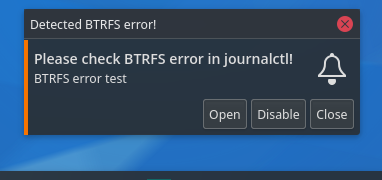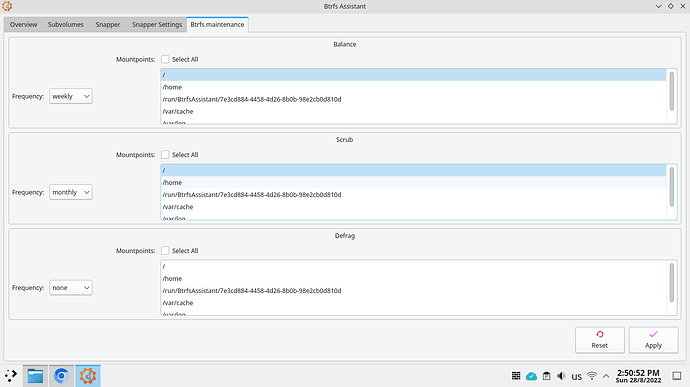Yes, I will do
snapper-snapshot-notification-git is available in AUR, but I know PKGBUILD doesn’t look good, because it doesn’t work with yay -R.
Don’t do this. This is broken.
sudo cp ./snapper-detects-snapshot /usr/bin/
sudo cp ./snapper-detects-snapshot.desktop /etc/xdg/autostart/
You don’t need sudo. Use install and $pkgdir. Look at the btrfs-assistant-git PKGBUILD
PKGBUILD was fixed. thanks for the explanation!
I just reinstalled everything after this grub fiasco, and Btrfs assistant install went smoothly. Grub is working with snapshots Thank you.
It is replaced by new AUR package btrfs-desktop-notification-git that added a new function and some options.
BTRFS notification will notify you when:
- Booting into any snapshot using Overlayfs
- BTRFS error appears in
journalctllog
There is configuration in /etc/btrfs-desktop-notification.conf
# Enable detection when booting into any root-snapshot on Overlayfs
DETECT_OVERLAYFS="true"
# Time frequency (secound) to check BTRFS error from journalctl log.
TIME_INTERVAL="2"
# Set custom terminal app e.g. konsole for KDE default terminal
TERMINAL="konsole"
# Set custom icons of the notifications
ERROR_ICON="btrfs-assistant"
INFO_ICON="btrfs-assistant"
How to test:
echo 'BTRFS error test' | systemd-cat -p err
Example:

After I made a fresh install and converted to sytemd-boot I am having the following (please see image)
I don’t know if I should tick any check boxes or modify anything!
The btrfsmaintenance defaults are pretty reasonable for most use cases.
If your btrfs filesystem in on a HDD, you might want to consider an infrequent defrag.
Thanks @dalto
I am on an SSD.
So I should leave it as it is.
Well, as usual, playing with the system to learn more!
My attempt to boot from a live USB, install BTRFS Assistant then:
- Restore my system to an earlier snapshot.
- Restore files from earlier /home snapshots.
I believe I installed in the live session (this is a copy/paste from terminal):
yay btrfs-assistant
yay -S btrfsmaintenance
yay -S snapper-support
yay -S snapper
yay -S snap-pac
Launching BTRFS Assistant from menu (XFCE - live session), it appears to me it just blinks (I see like a window opening then closing instantly)
How can I get BTRFS to work in live session (if possible)?
(I am on live session now)
Thank you.
Don’t install snap-pac or snapper-support in the live session. That seems like a bad idea. You should only need btrfs-assistant and snapper
You also need to mount some part of your btrfs filesystem.
I accessed the SSD from the file manager. But doubleclicking it does nothing.
I see its owner is root!
Its location is computer:///
How can I mount it? (Live session root password -which is…? or the real owner root password?)
sudo mount /dev/yourdevicehere /mnt
liveuser@eos-2022.06.23 ~]$ lsblk
NAME MAJ:MIN RM SIZE RO TYPE MOUNTPOINTS
loop0 7:0 0 1.6G 1 loop /run/archiso/airootfs
sda 8:0 0 232.9G 0 disk
├─sda1 8:1 0 300M 0 part
└─sda2 8:2 0 232.6G 0 part
sdb 8:16 1 0B 0 disk
sdc 8:32 1 29.3G 0 disk
├─sdc1 8:33 1 1.7G 0 part /run/archiso/bootmnt
└─sdc2 8:34 1 102M 0 part
sr0 11:0 1 1024M 0 rom
[liveuser@eos-2022.06.23 ~]$ sudo mount /dev/sda /mnt
mount: /mnt: wrong fs type, bad option, bad superblock on /dev/sda, missing codepage or helper program, or other error.
dmesg(1) may have more information after failed mount system call.
[liveuser@eos-2022.06.23 ~]$
Sorry, my bad
sudo mount /dev/sda1 /mnt
seems ok
It is probably /dev/sda2
That is wrong. That looks like your EFI partition.
It would probably help you if you added fstype to lsblk.
[liveuser@eos-2022.06.23 ~]$ lsblk fstype
lsblk: fstype: not a block device
![]()
Check lsblk --help or man lsblk.
Went fine, no error msg. Still cant browse the files on the BTRFS.
